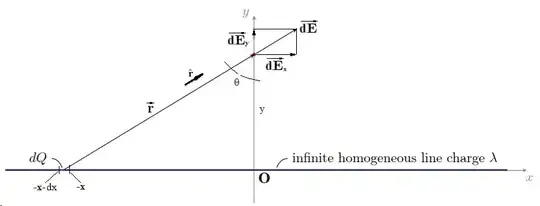Problem: I am currently tackling a problem involving the derivation of the electric field \$\textbf{E}\$ at location \$(0,y)\$ induced by an infinite homogeneous line charge \$\lambda\$ (refer to the provided image below). I have formulated the integral (last equation below).
Goal: Prior to seeking a solution, my primary aim is to ensure the accuracy of my derivation up to the last equation.
Question: Could you kindly review the equation and point out any errors or suggest improvements? I am solely interested in verifying the correctness of my derivation at this stage and not seeking a solution. Your insights would be greatly appreciated.
First, let's calculate an infinitesimally small charge \$dQ\$ on the line charge:
\begin{align} dQ = \lambda \cdot dx \end{align}
The electric field \$d\textbf{E}\$ generated by this infinitesimally small charge \$dQ\$ is defined as:
\begin{align} d\textbf{E} &= k \cdot \frac{dQ}{\Delta r^2} \cdot \frac{\Delta\textbf{r}}{\Delta r} = k \cdot \lambda \cdot \frac{dx}{\Delta r^2} \cdot \frac{\Delta \textbf{r}}{\Delta r} \end{align}
with the constant by Coloumb's law:
\begin{align} k=\frac{1}{4\cdot \pi \cdot \epsilon_0} \end{align}
and the displacement vector from \$dQ\$ to the point \$(0,y)\$:
\begin{align} \Delta\textbf{r}=\textbf{p}-\textbf{r}= y\cdot \hat{\textbf{y}} - (-x\cdot \hat{\textbf{x}})= y\cdot \hat{\textbf{y}} + x\cdot \hat{\textbf{x}} \end{align}
and the magnitude of the displacement vector:
\begin{align} \Delta r=\left|\Delta\textbf{r}\right|=\sqrt{x^2 + y^2} \end{align}
Proceeding to evaluate the integral:
\begin{align} \textbf{E} &= k \cdot \lambda \cdot \int\limits_{-\infty}^{\infty} \frac{1}{\Delta r^2} \cdot \frac{\Delta\textbf{r}}{\Delta r} \,\, dx \\ &= k \cdot \lambda \cdot \int\limits_{-\infty}^{\infty} \frac{1}{x^2 + y^2} \cdot \frac{x\cdot \hat{\textbf{x}} + y\cdot \hat{\textbf{y}}}{\sqrt{x^2 + y^2}} \,\, dx \\ &=\color{red!60!black}{ k \cdot \lambda \cdot \int\limits_{-\infty}^{\infty} \frac{-x\cdot \hat{\textbf{x}} + y\cdot \hat{\textbf{y}}}{(x^2 + y^2)^{\frac{3}{2}}} \,\, dx} \end{align}


\$k=\dfrac{1}{4\cdot\pi\cdot\epsilon_0}\$– Andy aka Dec 03 '23 at 11:33